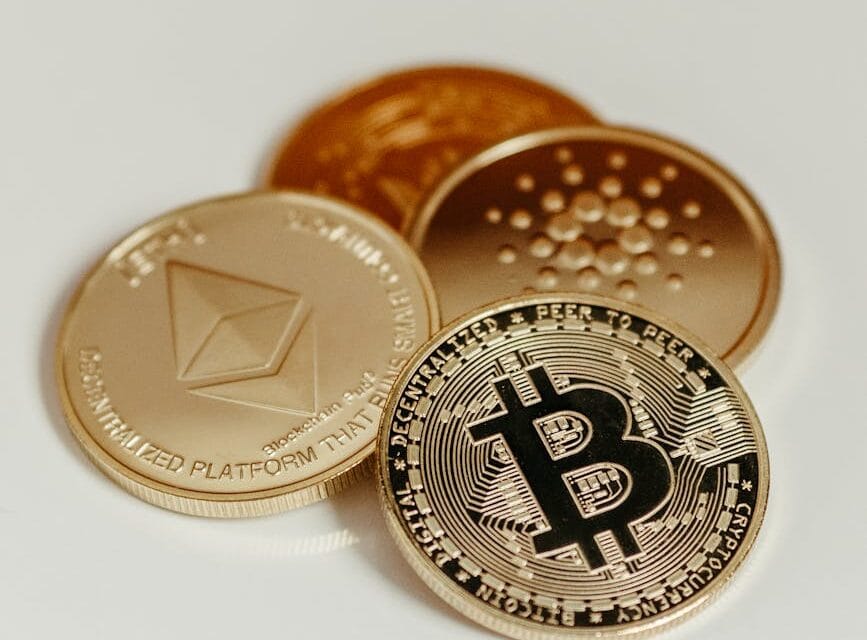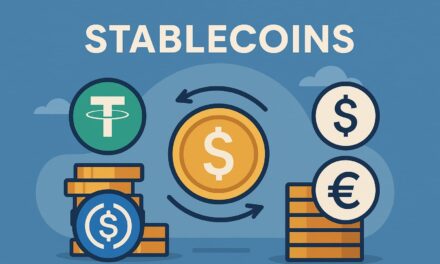This post will explore what Trump’s crypto executive order means for Bitcoin. But first, our disclosure.
Disclosure: This post may contain affiliate links, meaning we earn a commission on purchases made through those links at no extra cost to you. As an Amazon Associate, I earn from qualifying purchases.
Disclaimer: The content on this site is for informational and educational purposes only and does not constitute financial, investment, legal, tax, or any other professional advice and should not be used as a substitute for professional advice. For more details, read our full Disclaimer.
Trump’s Crypto Executive Order
On January 23, 2025, Trump signed the executive order “Strengthening American Leadership in Digital Financial Technology.” This was his first official executive order about cryptocurrencies, and he signed it just three days into his second term as president. Many consider the order a gift to the crypto community, which largely supported his campaign. They view it as a signal that Trump is ready to fulfill his promise to make the U.S. the crypto capital of the world.
To make the U.S. a global leader in digital assets, the executive order focuses on four primary goals:
- Protect individual’s and businesses’ rights to access open public blockchain networks, maintain self-custody of digital assets, and access banking services.
- Promotes the development of dollar-backed stablecoins
- Bans central bank digital currencies (CBDCs)
- Establishes the President’s Working Group on Digital Asset Markets responsible for creating a regulatory cryptocurrency framework and evaluating the potential creation of a digital asset stockpile
While President Trump’s executive order is good for the crypto industry, one group may have more questions than answers.
Where’s the Bitcoin?
The fast-food hamburger chain Wendy’s had commercials that featured an old lady asking, “Where’s the beef?” Trump’s crypto executive order has the Bitcoin community asking a similar question, “Where’s the Bitcoin?”
If you follow the Bitcoin community on social media, you know it has been bullish about Bitcoin since Trump’s election. Many Bitcoiners felt that Trump would issue an executive order establishing a Bitcoin Strategic Reserve within his first few days in office. However, not only did President Trump NOT establish a Bitcoin Strategic Reserve, but his crypto executive order didn’t mention Bitcoin by name. There is not a single mention of Bitcoin in the entire executive order.
Instead, Trump’s crypto executive order establishes a working group to evaluate the potential creation of a national digital asset stockpile within 180 days. Evaluating a digital asset stockpile does not guarantee one will happen. Moreover, if one is established, Bitcoin might need to share the spotlight with other cryptocurrencies.
The omission of Bitcoin in Trump’s executive order might be a tough pill to swallow for a community that often looks down on other cryptocurrencies. Instead of being the one and only crypto reserve asset, Bitcoiners may have to accept sharing the spotlight with other cryptocurrencies.
As someone who holds several other cryptocurrencies alongside Bitcoin, I do not view this in a negative light. While it is true that most cryptocurrencies are worthless or scams, that doesn’t mean they all are. Whether Bitcoiners want to admit it or not, other legitimate cryptocurrencies, like stablecoins, provide unique functionalities that can benefit the broader market.
Learn More About Bitcoin:
Stablecoins Over Bitcoin?
While Trump’s executive order on cryptocurrency does not mention Bitcoin, it references stablecoins three times. Stablecoins are the second priority outlined in the executive order. According to the “Strengthening American Leadership in Digital Financial Technology” executive order, one of its primary objectives is:
“promoting and protecting the sovereignty of the United States dollar, including through actions to promote the development and growth of lawful and legitimate dollar-backed stablecoins worldwide;”
Stablecoins are digital currencies tied to assets like gold or government currencies. For example, one of the most popular stablecoins, Tether (USDT), is pegged to the U.S. dollar, making USDT equivalent to one dollar. Tether achieves this by backing each coin with an equal amount of U.S. dollars held in reserve. Tether’s reserve includes cash and cash equivalents like short-term U.S. Treasury bills, leading many to call it the money market fund of cryptocurrencies.
Understanding stablecoins is important because hardcore Bitcoin enthusiasts see fiat currencies, like the U.S. dollar, as an inferior form of money. Trump’s executive order contradicts this belief. In contrast, Trump’s crypto executive order prioritizes promoting and protecting the sovereignty of the U.S. dollar through cryptocurrency. Rather than weakening the U.S. dollar, Trump aims to strengthen its global role through U.S. dollar-backed stablecoins.
I am not trying to insinuate that stablecoins are bad for Bitcoin or that Trump’s executive order somehow attacks it. Instead, I am pointing out that many hardcore Bitcoiners cannot stand fiat currencies and view Bitcoin as the next evolution of money. So, it is ironic that the first “Bitcoin President” is prioritizing using cryptocurrencies to promote and protect the U.S. dollar.
Why Stablecoins?
Stablecoins are popular in countries without a stable currency or government, where citizens have limited access to banking services and financial markets. Stablecoins, like Tether, offer people outside the U.S. the stability of the U.S. dollar along with a simple and cheaper way to transact and send money. In short, stablecoins fill a void left by less stable governments.
For the U.S. government, the popularity of dollar-backed stablecoins leads to more money going into short-term treasury bills. Short-term treasury bills are government-issued securities that help to bolster the Treasury cash balance. In other words, dollar-backed stablecoins not only help to uphold the supremacy of the U.S. dollar, but they also support the financial stability of the U.S. through their purchase of short-term Treasury bills.
Combine Trump’s executive order’s focus on stablecoins with its ban on central bank digital currencies, and you will start to have a clearer picture of Trump’s larger crypto strategy.
Crypto: Say “No” to Central Bank Digital Currencies
Central Bank Digital Currencies (CBDCs) are digital versions of a country’s currency issued by its central bank. CBDCs address many of the same challenges as stablecoins. They increase the money supply by reaching more individuals and providing a more cost-effective method for transactions and transferring money. Ultimately, similar to stablecoins, CBDCs can help reinforce the dominance of the U.S. dollar in the global economy.
Based on this description, CBDCs sound great, right? Why would Trump ban them?
For starters, CBDCs are just digitized forms of government fiat money. Fiat money is a government-issued currency not backed by a commodity like gold. The U.S. dollar and most other government currencies are fiat money. Bitcoiners despise fiat money and endless money printing, blaming it for runaway government deficit spending.
Furthermore, most Bitcoiners have a libertarian tilt. They don’t like big government, and they most certainly do like the Federal Reserve, whose control CBDCs would fall under if the U.S. adopted them. They view CBDCs as just another way for the government to run up bigger deficits while allowing it another tool to spy on and track its citizens.
Trump’s ban on CBDCs might be the biggest win for Bitcoiners who view them as an existential threat to individual sovereignty. The ban is the most definitive part of Trump’s crypto executive order. As such, it is safe to say CBDCs are off the table for at least the next four years.
The Crypto Working Group
While the ban on CBDCs is firm, the same is not true of the last crypto action item in Trump’s executive order. The Working Group on Digital Asset Markets is much more ambiguous, leading many Bitcoiners to wonder what’s next.
The Working Group has three important tasks.
- Identify and review all regulations, guidance documents, and orders impacting the digital asset sector within 30 days of the order.
- Submit a report within 180 days of the order, a proposal recommending a regulatory framework for digital assets.
- Evaluate creating and maintaining a national digital asset stockpile within 180 days of the order.
The first item on the list concerns gathering and reviewing information. It asks the Working Group to collect all the rules and regulations related to digital assets. After obtaining all the information, the group will recommend which rules should stay or go and which ones to change. From there, they move on to step two, which is to build a pro-crypto regulatory framework.
Many in the crypto industry have been begging for a clear regulatory framework. Crypto businesses want a regulatory environment that will drive growth and innovation across the industry, and Trump’s crypto executive order delivers on that promise.
Okay. So far, so good. Now, let’s move on to the most ambiguous part of Trump’s executive order.
What Is A National Digital Asset Stockpile?
On the campaign trail, Trump promised the Bitcoin community that he would create a Bitcoin Reserve if elected. However, Trump’s executive order on crypto has the Bitcoin community scratching their heads. Instead of outright creating a Bitcoin reserve, Trump’s order calls on the Working Group to evaluate the potential creation and maintenance of a national digital stockpile within 180 days. What the heck does that mean? And what is a national digital asset stockpile?
Nobody knows for sure what a national digital stockpile means. Right now, there are far more questions than answers. Will it contain only Bitcoin, or will other digital assets be included in the stockpile? If the Working Group does recommend a stockpile, how will it fund its creation? Is it possible that the Working Group will decide against creating one entirely?
Amidst all these questions, Trump does drop one tasty crumb to the Bitcoin community within his crypto order. In the same paragraph directing the Working Group to assess a digital asset stockpile, he also directs them to evaluate the potential creation of one using “cryptocurrencies lawfully seized by the Federal Government through its law enforcement efforts.”
At the beginning of 2025, the United States holds over 200,000 bitcoins that were seized through law enforcement efforts. These seized bitcoins are held by the U.S. Marshals Service, which periodically conducts auctions to sell them. Bitcoiners have been advocating for the government to stop this practice. Instead of selling off the Bitcoin, they argue that the government should use it to create and fund a Bitcoin strategic reserve.
So, is Trump giving the Bitcoin community a hint of what is to come? Maybe. Maybe not. For all his overtures to the Bitcoin community, Trump doesn’t appear to hold any Bitcoin.
The first “Meme Coin President”?
Meme coins are exactly what they sound like. They are for entertainment and are often popular among speculators and scammers. Meme coins derive their value from community engagement, not from their utility. Trump may not hold Bitcoin, but he loves meme coins and the blockchains they run on, like Ethereum.
Trump holds millions of dollars in the meme coin TROG, which is a blend of a frog and Trump. I’m not joking—this is real! In addition to that, he has millions more invested in his own meme coin, TRUMP. He also includes Ethereum (ETH) among his top cryptocurrency holdings.
Keep in mind that hardcore Bitcoiners despise Ethereum and can tolerate only a few meme coins. This makes for a strange marriage where one participant loves Bitcoin, and the other holds anything but Bitcoin.

Wrapped Bitcoin Vs. Bitcoin
Some Bitcoiners on X claim that Trump owns Bitcoin since he or one of his companies owns Wrapped Bitcoin. While both are related and have equal value, Wrapped Bitcoin (WBTC) is not the same as Bitcoin (BTC).
Wrapped Bitcoin enables holders of Bitcoin to use their Bitcoin on the Ethereum network. Users can exchange their Bitcoin for an equivalent amount of Wrapped Bitcoin. So, while they are not exactly the same thing, they do hold the same value. If Trump or one of his companies does indeed hold wrapped Bitcoin, then it would be advantageous for him if Bitcoin’s price increases as one 1 BTC equals 1 WBTC.
The most ironic thing about all this is that Bitcoiners cannot stand Ethereum, while Trump embraces it. They love to look down on it and belittle its value and purpose. However, the very president they are placing their dreams of a Bitcoin reserve has a crypto portfolio that is more closely aligned with Ethereum (and Solana) than Bitcoin.
Trump’s Crypto Executive Order: Putting It All Together
Trump’s executive order on cryptocurrencies confirms his commitment to an industry that contributed millions of dollars to his election campaign. The order addresses many concerns within the crypto community and establishes a Working Group responsible for creating a crypto-friendly regulatory framework.
While the crypto industry welcomed Trump’s order, many in the Bitcoin community were left disappointed as the order stopped short of establishing a Bitcoin reserve. Instead, it sets up a Working Group to evaluate the creation of a digital asset stockpile. What cryptocurrencies will be in that stockpile is anyone’s guess.
Considering Trump’s personal crypto holdings, anything might be fair game. Adding fuel to the fire, rumors are circulating that other cryptos, like Ripple (XRP), are lobbying hard for their inclusion in the stockpile. Needless to say, hardcore Bitcoiners are not happy with that prospect. So buckle up and grab some popcorn, as I expect a lot of drama in the months ahead.


![[OLD VERSION] TurboTax...image](https://m.media-amazon.com/images/I/41by2O4Eq5L._SL160_.jpg)














